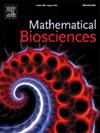Employing nullclines to balance treatment efficacy and neurotoxicity for sustained tumor control
IF 1.8
4区 数学
Q2 BIOLOGY
引用次数: 0
Abstract
There is increasing interest in identifying therapeutic regimens capable of maintaining tumor burden within well-defined size boundaries with constraints on the amount and frequency of drugs on a patient-specific basis. We have developed coupled systems of ordinary differential equations (ODEs) capturing the temporal dynamics of tumor burden, treatment effects due to cytotoxic drugs, and neurotoxicity. The models account for tumor cell proliferation and phenotypic heterogeneity, drug availability due to continuous or impulsive drug delivery, drug-induced apoptosis and microglia activation. We utilize nullclines of the system to derive effective dose ranges that stabilize tumor burden and mitigate neurotoxicity. Our results generate bounded treatment regimens that can be validated in the experimental setting. We found that for tumors with a proliferation saturation index (i.e., pre-treatment volume to carrying capacity ratio) between 0.10 and 0.30, containing the tumor in the sense of RECIST can yield up to a 51.8% reduction in drug concentration when compared with regimens designed for tumor eradication. In silico experiments using data from a breast cancer study demonstrate that the nullcline-derived treatments maintained stable disease in the tumors with neurotoxicity maintained below the desired threshold. The methodology developed in this study provides a theoretical formalism to potentially explain several preclinical and clinical observations indicating that low dose therapy can stabilize tumor growth and result in an enhanced quality of life. Importantly, our model identified quantitative biologic indices that can offer practical guidance to the design of personalized regimens that balance treatment efficacy and toxicity.
采用零线药物平衡治疗效果和神经毒性以持续控制肿瘤。
人们对确定治疗方案越来越感兴趣,这些治疗方案能够将肿瘤负荷维持在明确的大小范围内,并根据患者的具体情况限制药物的数量和频率。我们已经开发了常微分方程(ode)的耦合系统,捕捉肿瘤负荷的时间动态,由于细胞毒性药物和神经毒性的治疗效果。这些模型考虑了肿瘤细胞增殖和表型异质性、连续或脉冲给药导致的药物可获得性、药物诱导的细胞凋亡和小胶质细胞活化。我们利用该系统的零线来得出稳定肿瘤负荷和减轻神经毒性的有效剂量范围。我们的结果产生了有限的治疗方案,可以很容易地在实验环境中验证。我们发现,对于增殖饱和指数(即治疗前体积与承载能力之比)在0.10到0.30之间的肿瘤,与为根除肿瘤而设计的方案相比,在RECIST意义上含有肿瘤可使药物浓度降低51.8%。利用乳腺癌研究数据进行的计算机实验表明,nullcline衍生的治疗方法使肿瘤保持稳定,神经毒性维持在所需阈值以下。本研究中开发的方法提供了一种理论形式,可以潜在地解释一些临床前和临床观察结果,这些观察结果表明,低剂量治疗可以稳定肿瘤生长并提高生活质量。重要的是,我们的模型确定了定量的生物学指标,可以为平衡治疗效果和毒性的个性化方案的设计提供实用指导。
本文章由计算机程序翻译,如有差异,请以英文原文为准。
求助全文
约1分钟内获得全文
求助全文
来源期刊

Mathematical Biosciences
生物-生物学
CiteScore
7.50
自引率
2.30%
发文量
67
审稿时长
18 days
期刊介绍:
Mathematical Biosciences publishes work providing new concepts or new understanding of biological systems using mathematical models, or methodological articles likely to find application to multiple biological systems. Papers are expected to present a major research finding of broad significance for the biological sciences, or mathematical biology. Mathematical Biosciences welcomes original research articles, letters, reviews and perspectives.
 求助内容:
求助内容: 应助结果提醒方式:
应助结果提醒方式:


